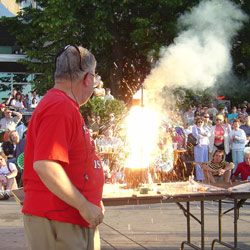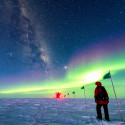Fireworks show a backdrop for fabulous science lessons
Renowned science educator Bassam Shakhashiri will take the stage on the Memorial Union Terrace Saturday, July 2 to give his annual “The Science of Fireworks” presentation.

Bassam Shakhashiri, the William T. Evjue Distinguished Chair for the Wisconsin Idea and a professor of chemistry, will give his annual “The Science of Fireworks” presentation on Saturday, July 2, at 8:15 p.m.
Shakhashiri, the William T. Evjue Distinguished Chair for the Wisconsin Idea and a professor of chemistry, plans to use the universal wonderment with fireworks as a platform to share the joy of chemistry.
“It’s fascinating how human beings are attracted to rapid color changes and loud noises, even though animals are usually adversely affected, frightened, by them. Rhythm and Booms, which we’ll watch across the lake after the talk, is a marvelous opportunity for people to gather and enjoy a vivid display of colors and sounds, and learn about chemistry,” he says.
The technology of fireworks, pioneered in China, contributed to the development of the science of chemistry, Shakhashiri says.
“These are uncontrolled combustion reactions, the Chinese and others later succeeded in devising ways to have these uncontrolled reactions take place in the sky; they had to figure how to get them up there and devise the composition of the different salts that cause different colors to happen, and it’s all chemistry,” he adds
In fireworks, light is emitted when electrons “fall” to a lower orbit during a chemical reaction and release a photon. The energy produced by each element has a characteristic wavelength, and therefore color, Shakhashiri says. “Higher energies correspond to shorter wavelengths, which produce a color in the violet/blue region of the visible spectrum. Lower energies correspond to longer wavelengths, at the orange/red end of the spectrum,” he says.
Uncontrolled combustion reactions have played a crucial role in history and chemistry, Shakhashiri says.
“We can’t look away from fireworks, but explosives and gunpowder caused a revolution in military technology that changed history,” he says. “And as people learned about the chemical behavior of substances, they became interested in how various combinations produced different colors and different amounts of heat.”
And although color production is now well understood, the phenomenon plays a vital and expanding role in science, Shakhashiri says.
“The observation of different chemicals making different colors is the basis of spectroscopy, which is used to analyze everything from trace elements in a CSI case to the composition of galaxies a billion light years distant,” he says.
Shakhashiri, the incoming president of the American Chemical Society, sees the world in chemical terms.
“Advances in technology based on chemical reactions led to the development of the microchip that enables us to do all kind of things in medicine, in car engines — everywhere — and it all depends on understanding the chemical nature of the world we live in,” he says.
Fireworks hold a special place for a scientist who has devoted his career to spreading scientific understanding. “Fireworks are so compelling,” says Shakhashiri. “You can see this on the faces of kids of all ages, from 5 to 95. But this is just chemistry in the sky: You cannot understand what goes on in the sky, or inside the body or the brain, without understanding chemistry.”
As in past years, Mike Leckrone and members of the UW Band will collaborate by bringing patriotic sounds to the evening.
“I want to remind us what the music and fireworks are really all about: They’re about Independence Day, about our freedom,” he adds.
The fun begins Saturday, July 2, at 8:15 p.m., on the Memorial Union Terrace, where Shakhashiri will be joined by Rodney Schreiner of the chemistry department. Scientific information on fireworks is available here.
Tags: events



